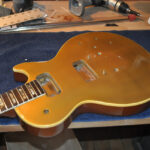The neck of an electric guitar is arguably one of its most crucial components, significantly influencing playability and overall feel. While personal preference plays a vital role in determining the “perfect” neck, understanding the objective factors that contribute to neck design is essential for any guitar player. This guide will delve into the key aspects of Electric Guitar Necks, helping you make informed decisions when choosing an instrument.
One of the primary considerations is neck thickness and profile. Players who favor fast styles often gravitate towards thinner necks, measured from the fretboard to the back of the neck. These necks, often paired with a flatter fretboard radius, facilitate quicker movements and can be advantageous for players with faster playing techniques. The width of the neck, spanning from edge to edge of the fretboard, also comes into play. Wider necks provide more space for fingers, reducing the likelihood of accidentally muting adjacent strings, particularly beneficial for players with larger hands or those still developing precise finger placement. This extra width can also accommodate more pronounced vibrato techniques without string collision.
Conversely, guitarists leaning towards blues or slide guitar styles may find necks with a more pronounced fretboard radius (a more curved surface) to be more comfortable. This curvature can aid in isolating individual strings, which is particularly useful for slide playing and bending techniques common in blues.
Beyond the neck profile, consistent action is a hallmark of a well-crafted electric guitar neck. Action refers to the distance between the strings and the frets. Inconsistent action, where the string height varies significantly along the neck, can make playing in certain positions unnecessarily difficult. Ideally, a quality neck will exhibit consistent action from the nut to the bridge. Lower action generally promotes faster playing, but setting it too low can lead to string buzz and a compromised tone, diminishing the guitar’s natural resonance and sustain.
The physical properties of the neck itself also contribute to the guitar’s sonic characteristics. Fatter necks tend to resonate more effectively, contributing to a fuller tone. Similarly, heavier headstocks can enhance resonance and sustain. The construction method also plays a role: neck-through body guitars typically offer the greatest resonance, followed by set-neck constructions (in quality instruments), and lastly, bolt-on necks. The type of wood used in the neck construction is another significant factor influencing resonance and tone. High-quality woods, prized for their resonant properties and lightweight nature, often come at a premium.
Historically, older guitars are often sought after partly due to the use of now-scarce, high-quality woods. Furthermore, older instruments frequently incorporated nickel parts, which are believed to offer superior resonance compared to steel. Nickel was more cost-effective in the past, but its increased expense today has led many modern manufacturers to opt for steel.
Ultimately, the most reliable indicator of a great electric guitar neck is feel. While objectively comparing neck specifications is helpful, the subjective experience of how a neck feels in your hand is paramount. Ideally, trying out different guitars with varying neck profiles is the best way to discover your personal preference and identify what feels most comfortable and conducive to your playing style.

